Welcome new readers of RMP’s quarterly H2 infrastructure report. Each quarter we look back on the major stories related to hydrogen infrastructure advancements and we compare the current AFDC database to the AFDC database in the prior quarter to see what has changed. The AFDC database is updated by the US Dept of Energy & can be found by clicking here. Canada does not have a centralized database of alternative fuel vehicle information so we collect Canadian data by hand. Ok, on with the report…
The opening quarter in 2020 has many important headlines but there are two major events for hydrogen infrastructure in North America that will be the focus of this article: 1) On March 5, 2020 the California Public Utilities Commission (CPUC) approved the Fuel Cell Energy & Toyota collaboration micro grid project that will use directed biogas from cow manure to produce 100% renewable #hydrogen for Class 8 trucks at the Port of Long Beach & the Port of Los Angeles. 2) On January 31, 2020 Air Products & the Orange County Transit Authority opened the largest fast fill hydrogen refueling station in America at OCTA’s Santa Ana Bus Base on the banks of the Santa Ana River in Southern Los Angeles.
The significance of the Project Portal approval is well conceptualized with a famous economic analogy. One of my favorite authors, Reed Jacobson, once wrote something in a computer programming book that has stuck with me for over 20 years: “Long before Henry Ford, and even before Marc Brunel, the economist Adam Smith reasoned that in a single day, a single worker could make only one straight pin, but ten people could subdivide the work and create 48,000 pins in the same day—an almost 5,000-fold increase in productivity.” The concept Reed was teaching in that one sentence was the concept of writing a ‘loop’ in a computer language. A loop is a chunk of computer code called a subroutine that specializes in one purpose & therefore can execute its special purpose very fast. If you spend the time to get that loop set up correctly, its payback to you in terms of run-time execution & lines of code reduced, is 5,000-fold. That powerful concept has helped improve productivity in our economy for hundreds of years in many different industries as well as helped me write more effective code for over twenty years now.
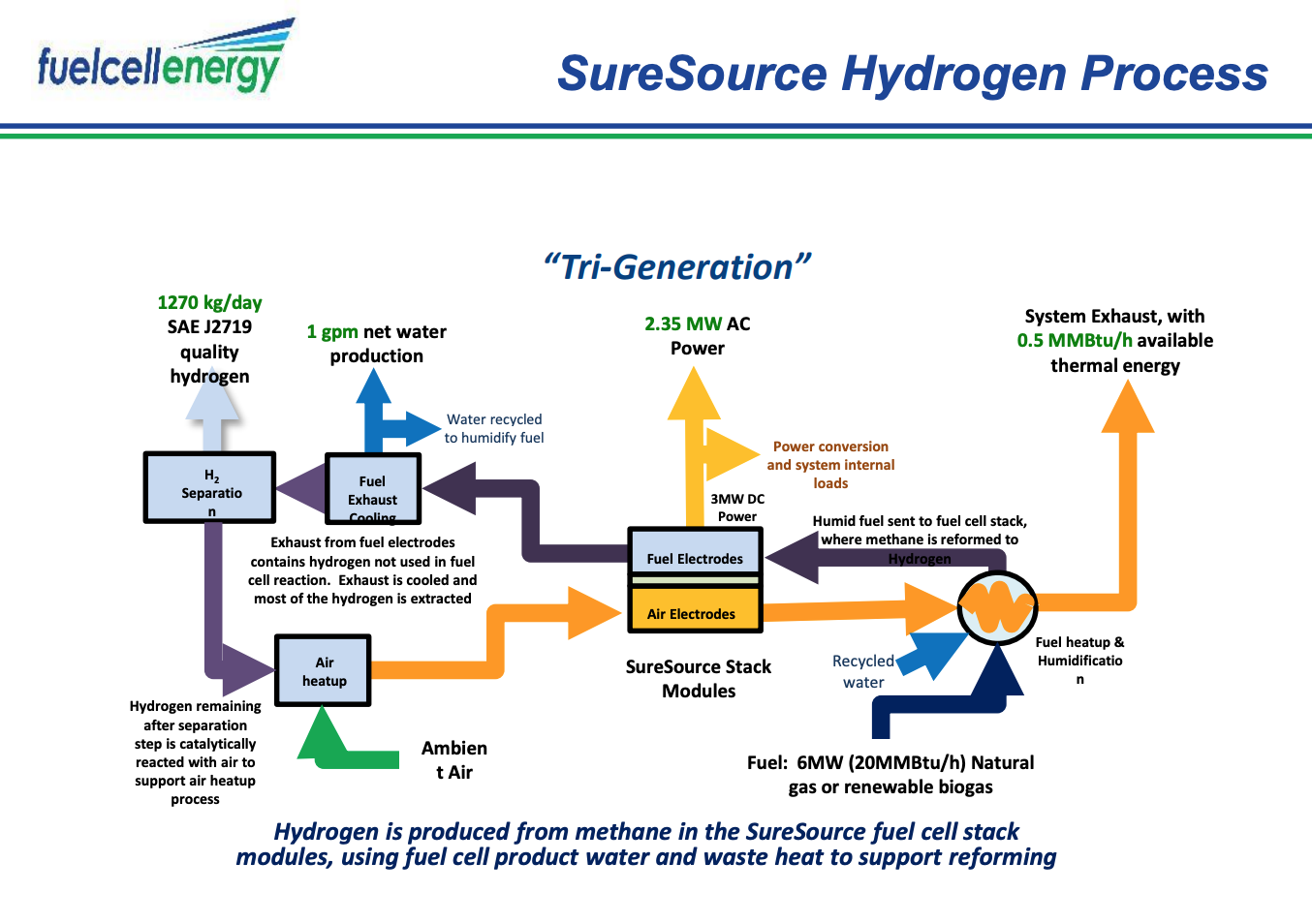
The ‘loop’ analogy is appropriate with regard to the two major hydrogen infrastructure advancements that both took place in California in Q1 of 2020. Both the large fast fueling OCTA bus station in Santa Ana & the CPUC approval of the biogas renewable tri-gen power plant at the Ports of Los Angeles & Long Beach represent the pioneer blueprints that can be rolled out all across the continent & all around the world just like a ‘loop’ subroutine. Each of these projects represent the hard work required up front to iron out the kinks of very complex energy systems like micro grids. The knowledge gained through the actual endeavor of generating sustained megawatt level zero emission energy is no easy task. Best practices learned & standards developed from these projects can be used to pave the way for other stations & microgrids with capital costs dropping by orders of magnitude over time.
Spend the time up front to write that ‘loop’ really well just one time, and you can just execute the same thing over & over again at an exponential increase in productivity thus dropping costs as you get better at it. We are at a crucial time in the nascent hydrogen economy where building more stations to serve the public is close to being a self-sustaining business model for entrepreneurial taxpayers. Soon, the momentum will increase where new stations are proliferating at a self-sustaining rate. Just like the years of effort put forth to build the Panama Canal to allow a single ship through has since allowed hundreds of thousands of ships to pass from Atlantic to Pacific; these pioneer stations provide the blue prints for long term sustainable energy at scale in a similar fashion.
The payback for building a micro grid hydrogen fueling station at the Port of Los Angeles will change the sustainable energy industry going forward. This very important power plant will demonstrate how zero emission tech can be better than pollution generating tech on a level economic playing field irrespective of its environmental benefits. Up until this point, people have been sacrificing higher cost to get to low emission, what if we could soon have both?

Let’s now look at the Project Portal approval by CPUC story which is the major headline of Q1. Then we’ll look at the OCTA station story in a little more detail. We’ll then look at a listing of other key North American infrastructure headlines throughout Q1. We’ll finish up with changes to the AFDC database. Let’s go.
PROJECT PORTAL:
Originally announced in late 2017, the megawatt scale carbonate fuel cell micro grid collaboration between Toyota Motor Corporation and Fuel Cell Energy LLC has finally been approved by CPUC as of March 5, 2020. The Long Beach Harbor Commission approved the $40M project funded by CARB in August of 2018. Immediately after its approval by the harbor commission, SoCal Edison stepped in to block the project from going forward. CPUC’s approval means SoCal Edison’s roadblock is finally cleared and construction can now move forward. This planned microgrid/refueling station is an infrastructure project RMP has been writing about for over two years because of its milestone significance in 100% renewable energy with a negative carbon profile. This upcoming facility will do more than provide 2.35MW of electricity, 1,270 kg of hydrogen per day, and hot water to buildings at the Ports of Los Angeles & Long Beach. The small footprint, quiet operation, trustworthy continuous power, & sophisticated ability to integrate into today’s modern electricity grids will demonstrate Project Portal as a blue print that can be copied at other ports around the country and world.
ABOUT THE FUEL CELL MICROGRID ITSELF:
“When designed and implemented properly, microgrids capitalize on all the benefits of fuel cells for on-site energy applications,” said Ben Toby, Senior Vice President, Direct Sales and Customer Service. “FuelCell Energy’s innovation in the development of fuel cell microgrids delivers all of the value streams of this cutting edge technology to our customers, including resilient, reliable, cost-effective clean energy.”
Microgrids are more than simple back up power applications. They require integration of critical loads and power generation sources with sophisticated approaches to grid independent operation, sometimes requiring multiple power generation sources to synchronize with each other and non-critical loads to be shed for seamless transition. FuelCell Energy’s microgrid technology has evolved over years of successful projects to effectively address the requirements of this important application. Fuel Cell Energy LLC (FCEL) has built successful microgrid solutions in California already at the University of San Diego and the maximum security jail in Santa Rita. FCEL has also built a microgrid at Pfizer’s R&D center in Connecticut at the University of Bridgeport. One of the value streams of this carbonate fuel cell microgrid will be pure hydrogen that will be used in PEM fuel cells in the trucks.
Drayage trucks at our ports represent a perfect captive market for hydrogen fuel cells similar to what we’ve seen with hydrogen fuel cell fork trucks. Plug Power makes fuel cells for fork truck fleets at Amazon & Walmart distribution centers across the country & around the world. Plug has demonstrated why high volume refueling using hydrogen has better fleet economics than any other zero emission tech. It has been proven that when you have more than 50 fork trucks in your facility, hydrogen fuel cells have better economics than batteries alone. That same fleet concept demonstrated by Plug Power, is similar with large Class 8 fleets at a more massive scale. Project Portal is a great demonstration that no zero emission tech can scale like hydrogen fuel cells. The first ten trucks to kick off Project Portal will be made in collaboration between Toyota & Kenworth. Let’s talk about the trucks.
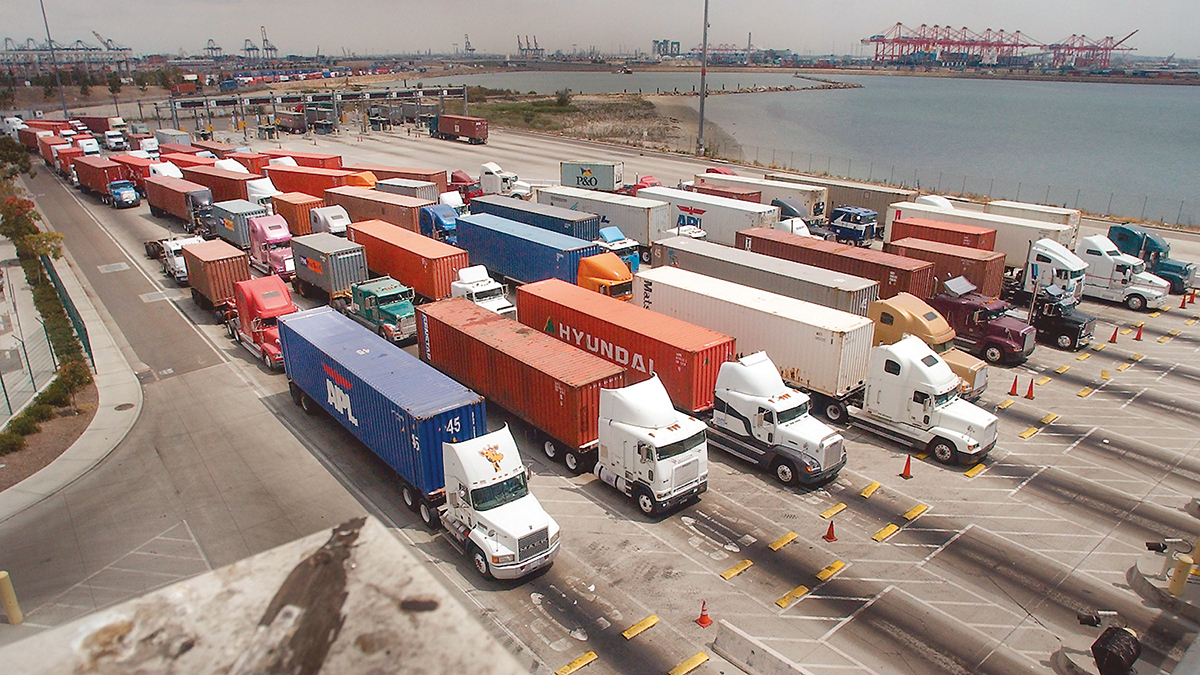
The Ports of Long Beach & Los Angeles currently see about 16,000 drayage trucks per day and it is estimated there will be 32,000 trucks in operation per day by 2030 according to the US Dept of Transportation & the Federal Highway Administration. Just over 25% of US port activity is recorded at the Ports of Los Angeles and Long Beach making them the #1 & #2 largest ports in America and they sit side by side on the same 130 acres almost as if they were one port. The Ports of Long Beach & Los Angeles have together earned the nickname: America’s Port. What better place to demonstrate hydrogen fuel cell scalability at the largest port in North America.
Already, Toyota & Kenworth’s “Alpha” & “Beta” trucks have logged more than 14,000 miles of regular drayage routes. The new Beta trucks have extended their range to over 300 miles which is about double the typical average daily duty of 150 miles required for drayage operations. Ten new zero-emissions fuel-cell-electric Kenworth/Toyota trucks will be developed through a collaboration between Kenworth and Toyota to move cargo from the Los Angeles and Long Beach ports throughout the Los Angeles area, the Inland Empire, the Port of Hueneme, and eventually to Merced. The trucks will be operated by Toyota Logistics Services (4), United Parcel Services (3), Total Transportation Services Inc. (2), and Southern Counties Express (1).
Two new large-capacity heavy-duty hydrogen fueling stations will also be developed by Shell in Wilmington and Ontario, California to eventually extend Project Portal. The two new stations will join three additional stations located at Toyota’s Long Beach Logistics Services and Gardena R&D facilities to form an integrated, five station heavy-duty hydrogen fueling network for the Los Angeles basin. Together, these stations will provide multiple sources of hydrogen throughout the region, including over one ton of 100% renewable hydrogen per day at the Toyota Logistics Services station to be operated by Shell, and important research and development advances at a pair of stations operated by Air Liquide, all enabling zero-emissions freight transport.
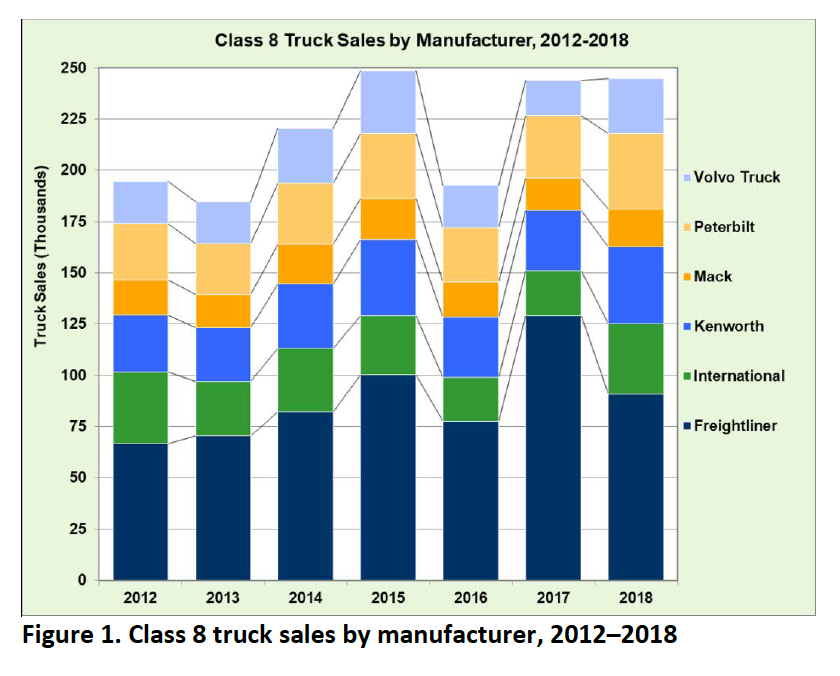
Expanded use of zero-emissions technology in the cargo terminal and warehouse environments will also get in on the hydrogen action, including the first two zero-emissions yard tractors to be operated at the Port of Hueneme, as well as the expanded use of zero-emissions forklifts at Toyota’s port warehouse. Forklifts, cars, & Class 8 tractors will all be sharing the same fuel from the same type of dispenser. I think it’s very important to contrast hydrogen to hydrocarbons in this regard as the J2601 hydrogen refueling standardization protocol gives huge cost savings advantages to h2 over refined crude oil products.
Because of the way oil is extracted from the earth, you get waste water, propane, butane, crude oil, and a host of other nasties that all need to be separated & processed both at the well head and many more points downstream before refined fuel can go into your vehicle. Fork lifts generally run on propane. Cars typically run on gasoline. Class 8 trucks generally run on diesel. All those different fuels get different processing & logistics. Plus, you can’t swap a propane forklift’s fuel for diesel because propane & diesel don’t work that way. With hydrogen, vehicles are on the same refueling platform. With hydrogen, it’s all the same nozzle. With hydrogen, it’s all the same dispenser. Contrast that to hydrocarbons: racks & racks of empty & full propane tanks that need to get swapped out of fork trucks & refilled on a daily basis. Separate overground & underground tanks for gasoline & diesel that require large footprints & special regulations & have a history of leaking and contaminating ground water. Think even further upstream: cracking plants to turn raw hydrocarbons into propane, butane, gasoline, & diesel. Think further upstream from that, massive platforms built & sent out into deepwater to drill for oil. It’s madness. Think about how all of that effort [& money] is wasted as compared to how we can make hydrogen from renewable energy & water in our backyards. I challenge you to think about those points, because they’re all true and important from a cost perspective.
While I tend to think about the nerdier parts of the hydrogen economy & how good hydrogen can be for society, I know what people really want is a salacious headline or something exciting & tantalizing. So, in the spirit of giving people what they want, here is a very short video clip of a Toyota/Kenworth Class 8 fuel cell truck kicking the butt of a Class 8 diesel truck in a drag race before we get on to the second major story of Q1-2020.
OCTA Hydrogen Bus Refueling Station:
On January 31, 2020 OCTA debuted the nation’s largest hydrogen fueling station and 10 zero emission fuel cell electric buses. The $22.9 million dollar project was in large part made possible by support received from California Climate Investments who’s mission is to put cap&trade dollars to work. Other funding for the fuel cell buses comes from SB1 State of Good Repair funds, administered by Caltrans, and from the South Coast AQMD Clean Fuels Fund.
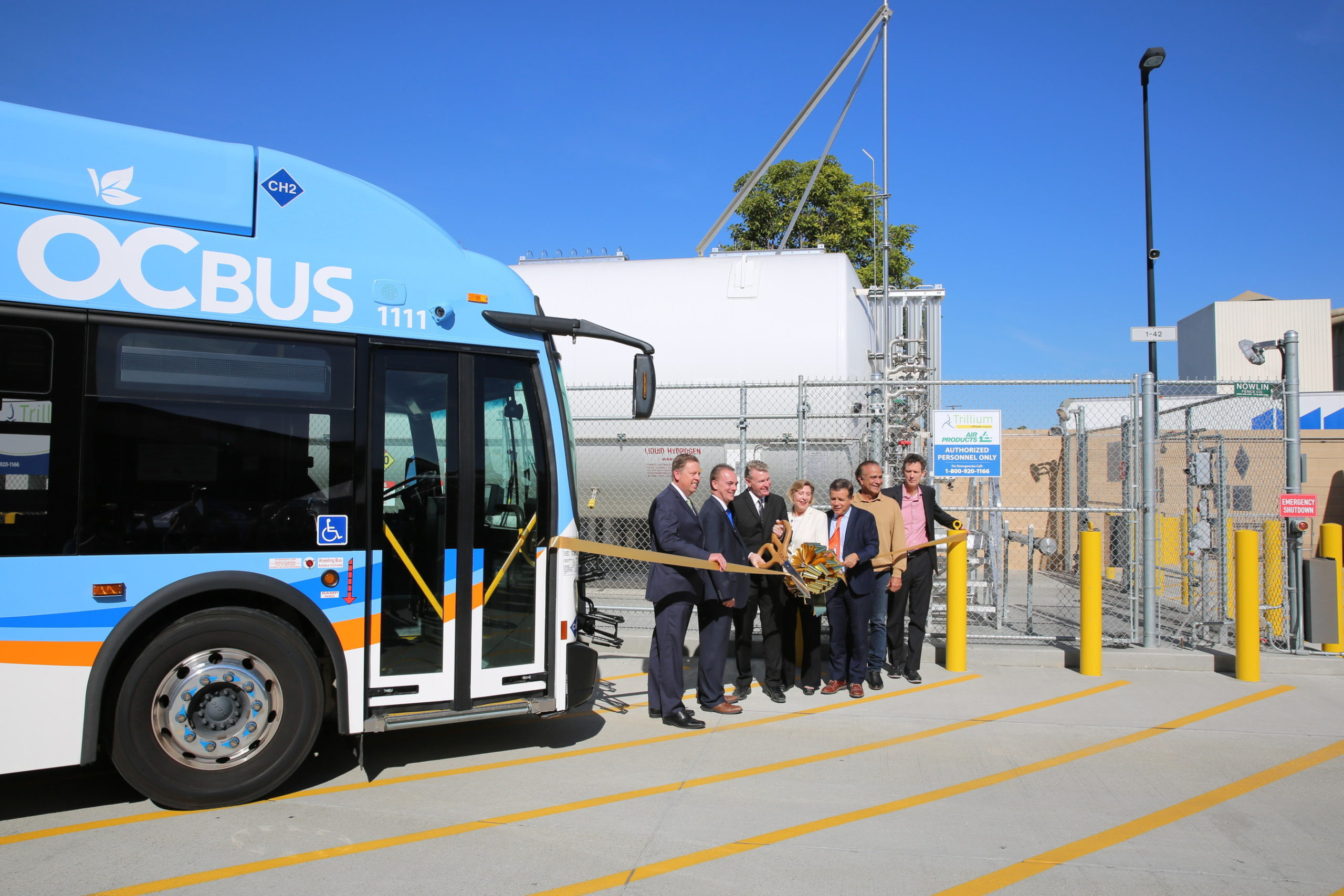
The new fueling station is equipped with Air Products’ SmartFuel® hydrogen fueling technology, design, and equipment. OCTA’s current hydrogen fuel cell electric bus fleet is comprised of 10 buses, but the station is built for future growth. It has a bus fueling capacity for up to 50 buses, which corresponds to fueling up to 1,500 kilograms (kg) of hydrogen in an eight-hour time period. The station can fuel transit buses with an average of 28 kg of hydrogen per bus in a time frame of 6 to 10 minutes per bus, while also providing back-to-back bus fueling for up to 30 buses and simultaneous fueling capability with multiple fueling lanes.
Let’s do some quick math on the new OCTA station. Given a theoretic 4,500kg per day capability and hydrogen’s energy equivalency of 33.33 kWh/kg, that’s a conversion of 150 megawatt hours per day of refueling capability with a small footprint that puts no burden on the electrical grid. That’s pretty damn impressive. Especially if the hydrogen is 100% renewable like the 1,270kg/day at Project Portal. Remember, there are zero off-grid Supercharger battery chargers in the world even though Elon Musk promised nearly 3 years ago (6/9/2017) that all of Tesla’s Superchargers would convert to off-grid renewable solar & wind. The reason there are still zero off-grid Superchargers nearly three years after Elon Musk said all would be off-grid renewable is because it simply is not feasible; real world energy just doesn’t work that way. I would love to see the very first renewable wind or solar fast charging battery station so I could better understand its economic profile but alas it’s still a unicorn.
Trillium was contracted for construction, operations and maintenance of the new OCTA fueling station, and New Flyer provided the buses. Ballard worked on the hydrogen fuel cell electric technology on the buses. And Fiedler Group engineered upgrades to maintenance facilities to safely service the hydrogen-fueled buses. CTE, a nonprofit transportation consulting firm specializing in the development of zero-emission solutions for public transit, organized and led the team to successfully win a grant from the California Air Resources Board to launch this project.
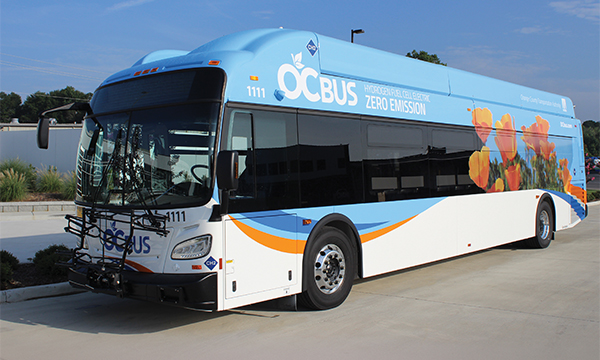
“We are very happy to be leading the way toward a cleaner and greener future that keeps the residents of Orange County moving, while keeping the air they breathe healthy with zero emissions,” said OCTA Chairman Steve Jones, also the Mayor of Garden Grove. Representatives from the partners in the project, including the California Air Resources Board (CARB), South Coast Air Quality Management District and Center for Transportation and the Environment (CTE) were in attendance for opening event.
“California’s transit agencies are leading the revolution to zero-emission transportation by taking action to replace their fossil-fuel powered buses with the very cleanest models available,” said CARB Chair Mary D. Nichols. “The Orange County Transportation Authority is among the state’s and the nation’s leaders in this crucial effort. This project will accelerate the commercialization of hydrogen fuel cell powered buses. It also showcases today’s hydrogen fueling facility to keep those zero-emission buses powered up and clearing the air.”
That’s it for our two big stories in Q1-2020 but there was a lot more happening than just those two headlines. Let’s check out other updates in Q1-2020.
New H2 Stations That Opened To The Public 2020 Q1:
The third of three Shell stations in San Francisco opened on Mission Street on February 14, 2020. The station’s storage capacity is 560kg and it will be open 24hrs to the public. 560kg * 33.33 kWh/kg = 18,665kWh in total that can be dispensed out of two pumps simultaneously. 560kg / 5kg = 112 fill ups of a typical full size car like a Toyota Mirai or conservatively 33,600 miles of driving from its nameplate capacity. Theoretic capacity is even higher if sustained refuels from two pumps take place at 66KW per minute around the clock. Those are strong numbers for Shell in a small footprint. That’s handling a lot of vehicles without using a lot of acreage. There are 8 First Element Fuel (True Zero) stations in various stages of development that will all have 1,200kg of capacity & are forecast to open in California in 2020. (Sunnyvale, Campbell, Mission Hills, Fountain Valley, San Diego, Redwood City, and Culver City).
Other Hydrogen Infrastructure Headlines 2020 Q1:
January 4, 2020 – According to a study carried out by the Center for Transportation and the Environment (CTE), a nonprofit organization with a mission to improve the health of our climate and communities in the USA. The range of e-buses is reduced by up to 37.8% at 0 to -5 ° C – whereas Fuel Cell Buses only lost 23.1% of range in similar conditions. Read more here at https://fuelcellsworks.com/news/study-by-cte-cold-weather-effects-range-loss-in-winter-fuel-cell-beats-battery/
January 14, 2020 – Fuel Cell Energy releases a document about all their microgrids and where they are located. https://www.globenewswire.com/news-release/2020/01/14/1970270/0/en/FuelCell-Energy-Details-Microgrid-Performance-Successes.html
January 20, 2020 -Air Products announces they’re hiring several Transfill Operators at their liquid h2 plant in Long Beach CA. Remember that in September of 2018 & again in January of 2019, Air Products announced two more hydrogen liquefaction facilities to meet growing demand in traditional hydrogen markets as well as the demand being created by a growing number of FCEVs on the road. Link to job opening: https://www.glassdoor.com/job-listing/transfill-operator-southern-california-air-products-JV_IC1139117_KO0,38_KE39,51.htm?jl=3452748974
Air Products press release announcing new liquefaction facilities: http://www.airproducts.com/Company/news-center/2019/01/0107-air-products-to-build-second-liquid-hydrogen-productions-facility-in-california.aspx
Air Products has h2 liquefaction plants in Sacramento California, New Orleans Louisiana, in the US as well as Sarnia Ontario in Canada & Rotterdam Denmark. A 2nd liquefaction plant in California is under construction & anticipated to open in Q1 2021 but the stories don’t say where it’s located. Air Products announced in Sep 2018 that they’re also building another h2 liquefaction plant in La Porte Texas. Air Products is also currently upgrading their liquid hydrogen transfill facility in Wilmington CA which is also very near the Long Beach transflll facility that is growing in activity, upgrades, and number of employees. As RMP has reiterated a thousand times: more hydrogen = more American jobs; and, you can never run out of hydrogen.
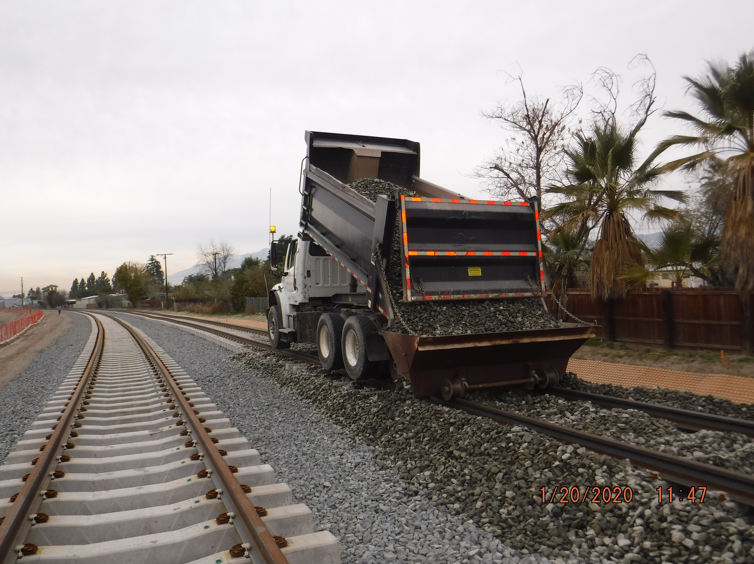 2/15/2020 – This picture from the Redlands Passeger Rail project was taken on January 20th, but released on the Feb 15 newsletter. It shows progress continuing on the USA’s first #hydrail project. Read RMP’s story on this hydrail project & see it on our map by clicking here. California Governor Newsome’s most recent executive order declared the transportation and construction sectors as critical and work will continue on this project through the COVID-19 crisis of 2020.
2/15/2020 – This picture from the Redlands Passeger Rail project was taken on January 20th, but released on the Feb 15 newsletter. It shows progress continuing on the USA’s first #hydrail project. Read RMP’s story on this hydrail project & see it on our map by clicking here. California Governor Newsome’s most recent executive order declared the transportation and construction sectors as critical and work will continue on this project through the COVID-19 crisis of 2020.
3/23/2020 – Toyota plans a truck for Hino Subsidiary.
https://www.reuters.com/article/us-toyota-fuelcell-truck/toyota-plans-to-develop-fuel-cell-truck-with-hino-unit-idUSKBN21A0G6
AFDC Database Updates from 2020 Q1:
In comparing the AFDC database from March 31, 2020 to December 31, 2020, the following changes are noted: The South Coast Air Quality Management District – Diamond Bar station was removed & re-added to the database with a new id#, I don’t know why this station was re-added. The Air Products and Chemicals Inc – West LA station was removed from the database. The National Park Service – Brentwood Maintenance Facility in Washington DC is no longer on the database. The First Element Irvine & Santa Monica stations have been removed from the database. The OCTA Santa Ana bus station that is one of our two lead stories in this quarterly edition was added to the database.
All the stations on the AFDC database discussed in this article are mapped on RMP’s Google Map updated as of March 31, 2020 which you can view by clicking here. Note that the Project Portal refueling station, however, is not yet on our map as it is not on the AFDC database. When the USDOE puts the Project Portal station on the database, it will be on our map too.
FCEVs On American Roads:
The table below shows Vehicles In Operation (VIO) on USA roads sorted by county from IHS Markit which is the premier source for automotive market data. The top 24 counties are shown with all others counties combined as the 25th. The numbers of cars on the road is limited by the refueling capacity which is why RMP focuses on hydrogen infrastructure each quarter. The number of cars on the road will increase in relation to True Zero’s new 1,200kg capacity stations coming online soon. Understanding how many cars are on the road is an important metric to help make sense of how many stations (i.e. kilograms) can serve how many cars.
Big data lags behind real time. It takes IHS about 1.5 months to publish data after their quarterly cut-off. The column Q1-2020 below, for example, represents the number of registered vehicles on the road at 1/1/2020 and the numbers were published on 2/15/2020.
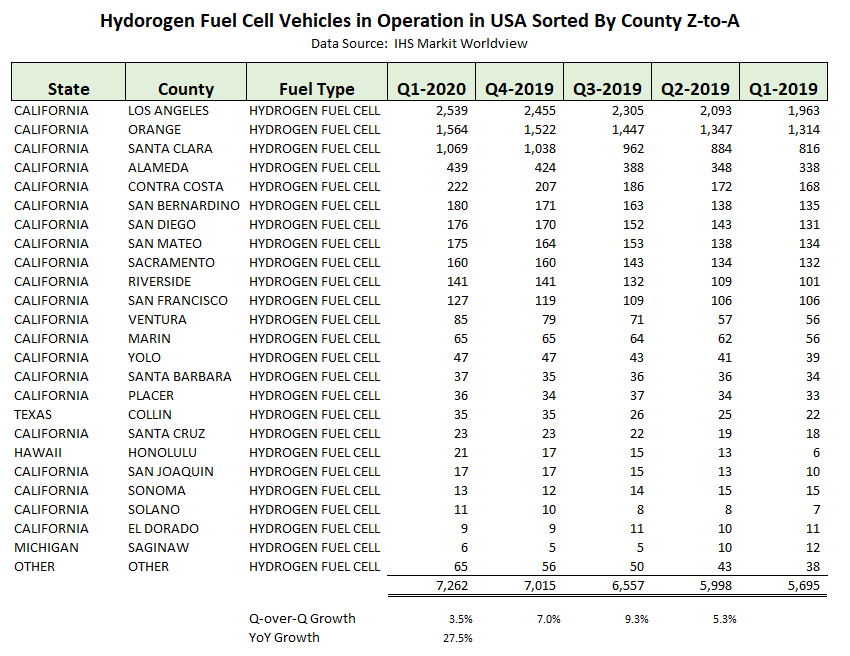
The next table is the same VIO data as above but filtered by type of car & OEM.
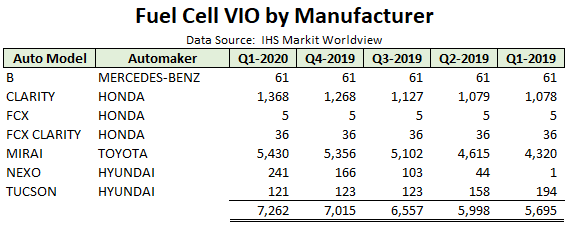
Final Remarks for 2020 Q1:
Cow manure. Pig manure. Chicken manure. Who knows what those three types of waste represent in America? First off, they represent one of the pillars of why I founded RMP & registered it as a non-profit 501(c)3 organization: RMP’s underlying mission is to protect our freshwater natural resources and animal farm waste is a big part of what pollutes our water. Concentrated Animal Feeding Operations (CAFO’s) are defined as farms with over 1000 animal units that are confined for over 45 days a year. An animal unit is the equivalent of 1000 pounds of “live” animal weight. A thousand animal units equates to 1000 cows, 700 cows used for dairy purposes, 2500 pigs weighing more than 55 lbs, 125,000 chickens, or 82,000 egg laying hens or pullets. All the solid waste produced by CAFO’s (& other animal farms too) represent a large burden on the US economy. Americans eat a lot of beef, bacon, chicken & eggs, which means there’s a lot of “shit” that’s got to go “somewhere”. And, when I say “somewhere” it really means into our drinking water & where we catch our fish.
Solid waste from animal farms is expensive to dispose legally. So what do cash strapped farmers do with tons of manure? They spend even more money and effort to spread it across hectares of American farm land and call it “fertilizer” but it’s just a ruse to get rid of it more cheaply than building processing facilities & getting discharge permits from government authorities. Then what happens? The rains wash that “fertilizer”, which is really just manure, into our creeks which flow to our streams & rivers and eventually to our lakes.
In Michigan, we get massive algal blooms polluting Lake Erie, and people honestly wonder why the phosphorus levels are so damn high without understanding what I just described. It doesn’t take a tenured environmental science professor to understand where the phosphorus is coming from, it’s the shit. The NOAA has an entire webpage for predicting what’s called the Lake Erie Harmful Algal Bloom Forecast (HABF). We keep on polluting on a massive scale, then we spend additional money on a massive scale to track the devastating effects of that pollution. The Hydrogen Economy asks why? Why would we do that? Why not use the manure for the good of the economy instead of putting it in your drinking water? Seems like common sense, right?
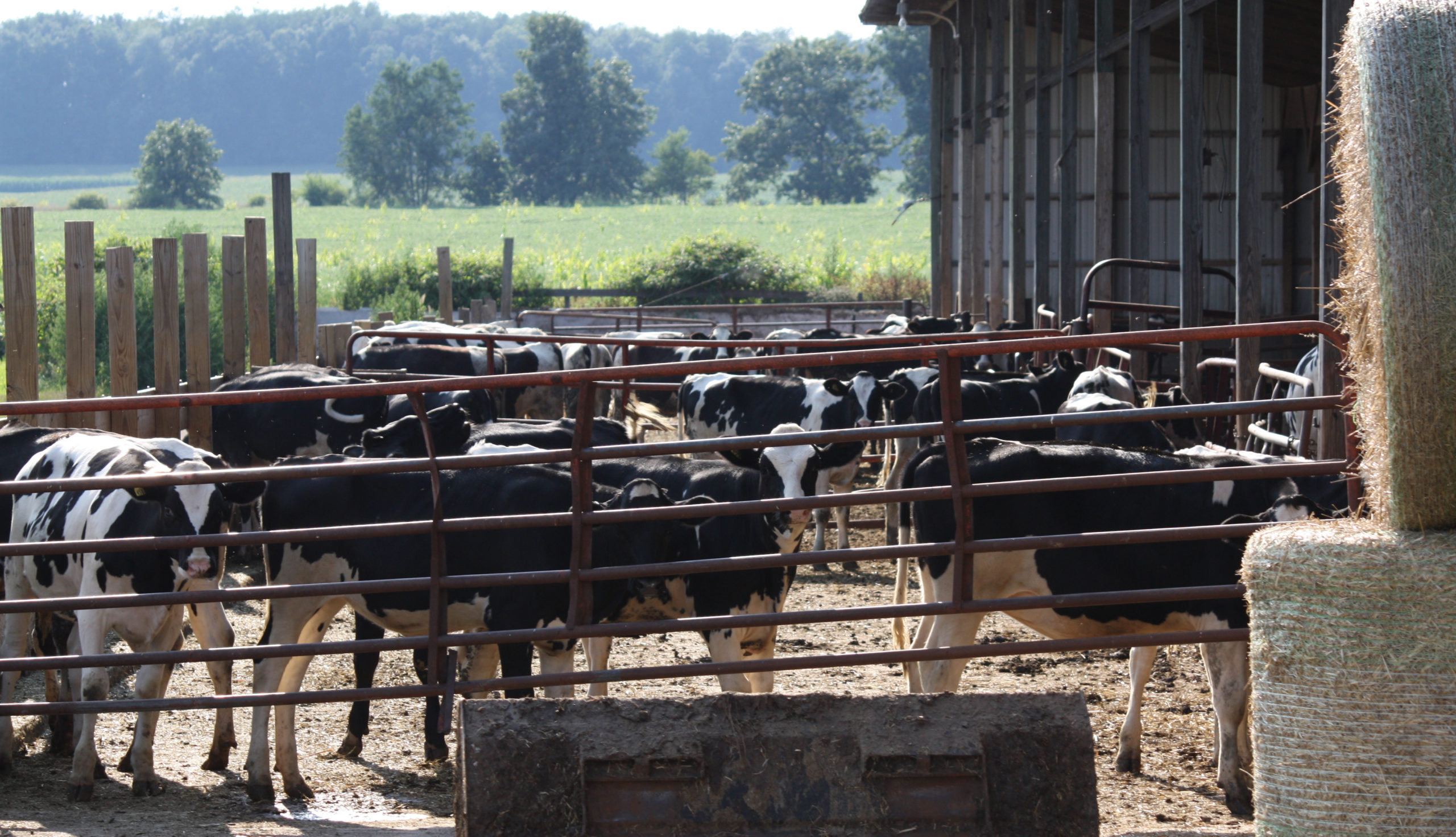
America also has a large oil import deficit (over 65% before fracking & btwn 10-20% since fracking) as a percentage of our total import deficit. Hydrogen can eliminate our oil import deficit, ween us off of domestically produced oil, and supplant oil for energy with domestically produced clean fuel like cow manure. The benefits are incredible. Refined oil products like gasoline & diesel do unimaginable damage to our freshwater resources as 100s of millions of gallons sit in storage tanks both above & below ground. Those tanks leak & pollute our groundwater causing contamination lasting decades and resulting in expensive environmental remediation efforts. Animal farm manure pollutes our water just like crude oil products but in more clandestine way.
Project Portal will use cow manure to power Class 8 trucks. Class 8 trucks keep America’s economy running. Truckers have a saying: “if you bought it, a truck brought it”. The website truckersreport.com says that 73.7% of stuff in your life was delivered to you by a truck. Toyota & Kenworth’s efforts will divert cow manure into becoming clean hydrogen energy to power their trucks. While doing so, that cow manure will supplant the use of oil which also pollutes our air & water. All of these environmental benefits, all of these cost saves, will create American jobs & prevent American money from going to countries hostile toward us. See you next quarter, stay safe from the virus, and thanks for reading.

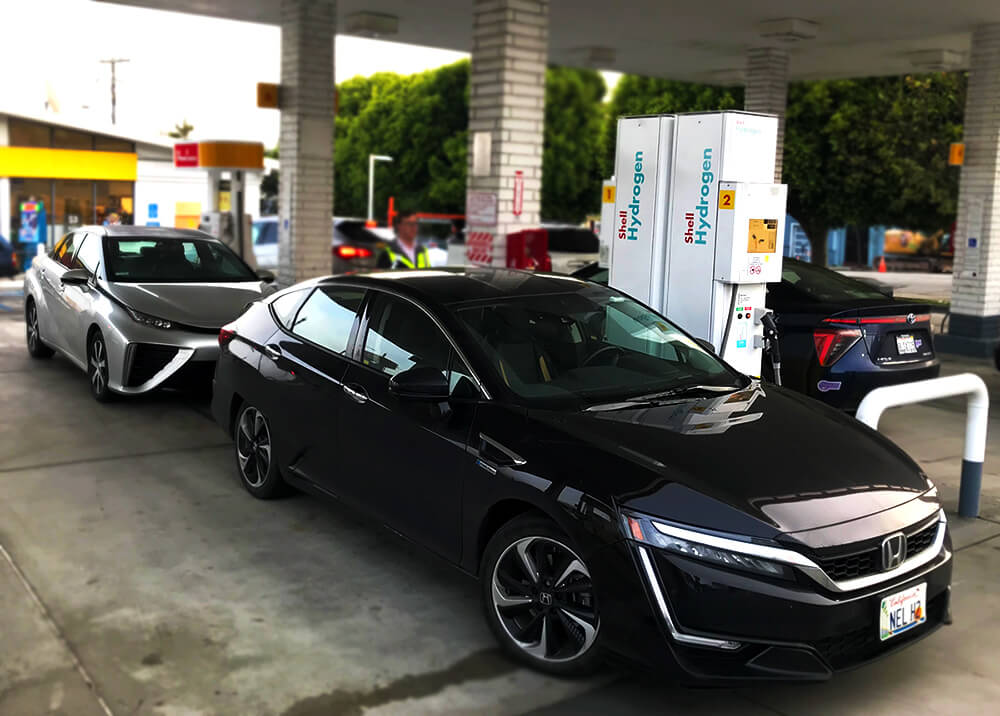

Leave a Reply